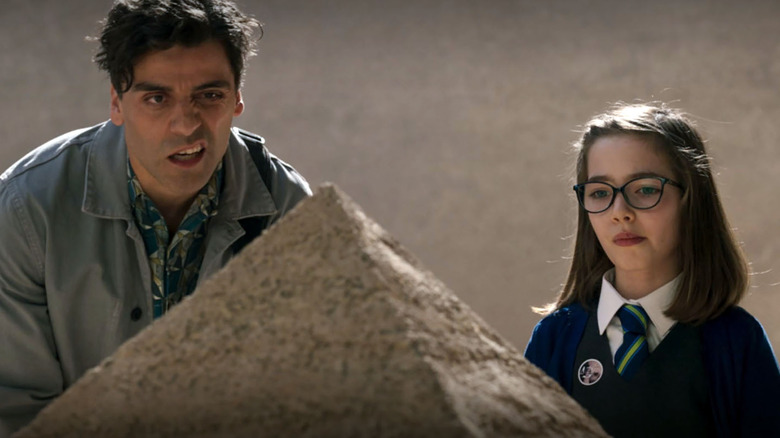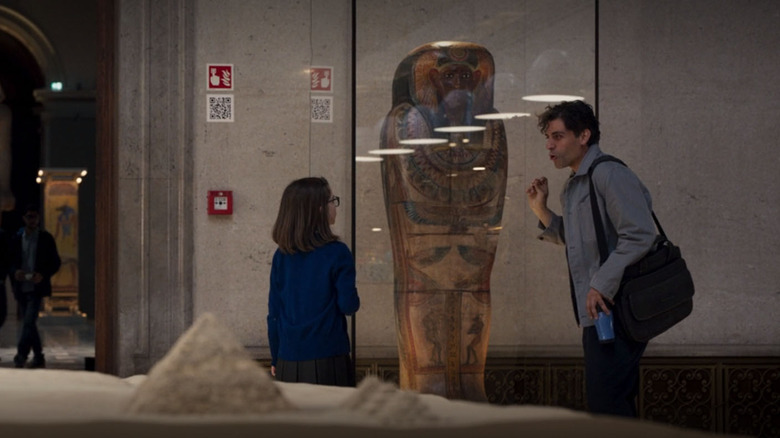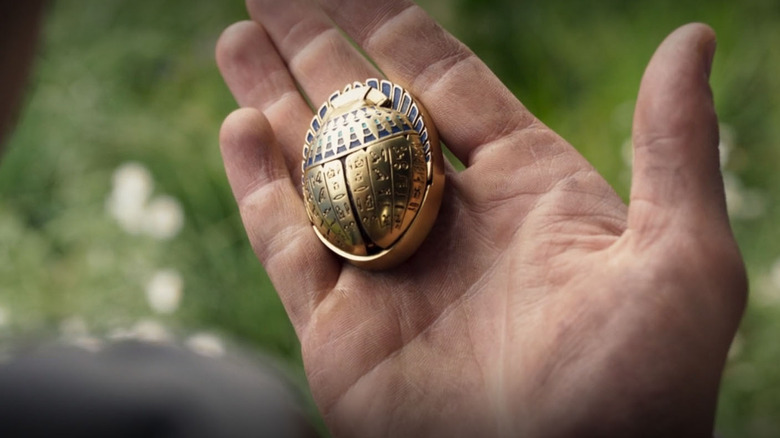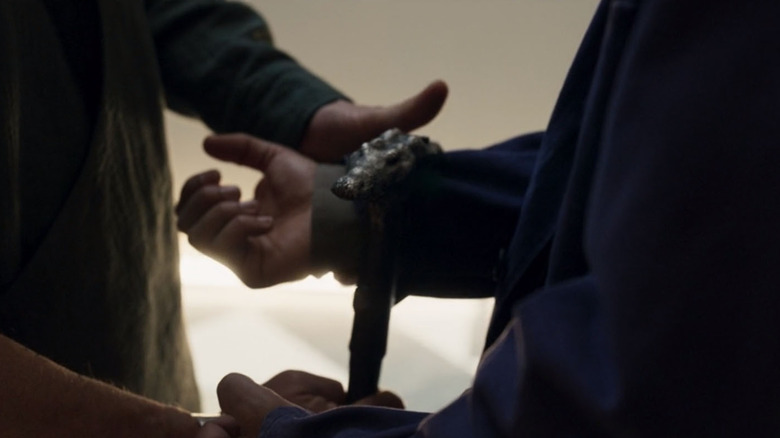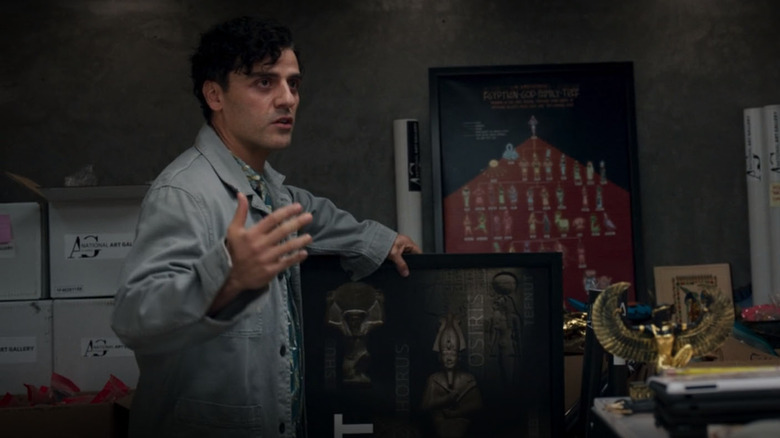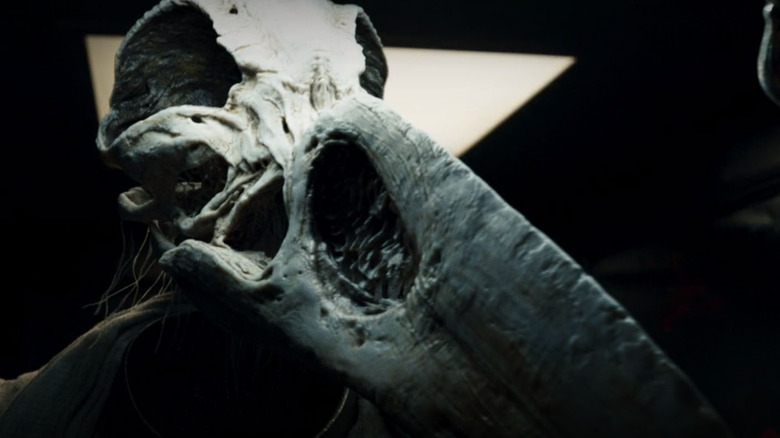The Real History Of The Egyptian Gods In Moon Knight
If all of the references to the history and mythology of ancient Egypt in "Moon Knight" made you look like Steven Grant (Oscar Isaac) in the image above, don't worry; I've got you covered. The latest Disney+ series is based on the Marvel comics of the same name, but they are both heavily inspired by ancient Egyptian mythology. After all, Steven Grant and his alter-ego Marc Spector are the vessel for the Egyptian god of the moon, Khonsu (spelled Khonshu in the comics/series), and he does battle with the forces of the goddess of judgment, Ammit. These gods have their basis in the myths and legends of ancient Egypt, and are connected to many other familiar gods and their stories. Read on to learn about the facts behind Steven's explanation of mummification, the golden scarab, and some of the gods that make "Moon Knight" so rich and fascinating.
Spoilers for episode 1 of "Moon Knight" ahead.
An obsession with the afterlife
Towards the beginning of the episode, Steven educates a little girl visiting the museum on mummification techniques, including the practice of removing all of the body's organs through the nostrils. She is both fascinated and disgusted, but Steven's story is based on fact. The civilization that grew around the Nile river valley during the Bronze age used mummification to preserve the bodies of their dead because of the belief that people needed their bodies in the afterlife. The lungs, stomach, liver, and intestines were each placed in canopic jars with a different god depicted to protect each, while the brain was thrown away and the heart was left in the body. The heart was believed to be the seat of the soul, and it was weighed against the goddess Ma'at's feather on the scales of justice. If the heart was lighter than the feather, the person could pass through into the afterlife. If the heart was heavier, then it would be devoured by the goddess of judgment and retribution, Ammit.
The pyramids themselves are symbolic of this ancient obsession with death and the afterlife, as they are massive tombs, filled with dead rulers and their servants and slaves. While many people nowadays joke that material objects don't have meaning because "you can't take them with you" into the afterlife, the ancient Egyptians believed the exact opposite. Life on Earth was just the first part of the adventure, and death serves only as the passageway to the next world. It's funny that the little girl asks Steven about whether or not he would be allowed to the "field of reeds" of the afterlife and he responds with "I'm not dead," because his unique position as the vessel of a god puts him somewhere outside of the "living."
An elaborately decorated poop bug
The scarab that Ethan Hawke's Arthur Harrow wants to get so desperately from Steven is a gorgeous little artifact, and has its own basis in mythology. Much of what we know about burial and death rituals in Egypt during this time period comes from the Book of the Dead, a collection of magical spells that people turned to like we might turn to WebMD. The prescription for ensuring someone's heart was lighter than Ma'at's feather was to make a scarab of nephrite (a kind of jade), adorn it with gold, and perform a ceremony with a spell, anointing the scarab with myrrh and placing it in the deceased's chest. These scarabs, called heart scarabs, have been found in a number of tombs and were an important part of burial rituals.
A scarab is a type of dung beetle, named so because they roll up balls of dung. In ancient myth, the scarab god Khepri rolled up the sun itself like a ball of dung. The sun god Amun-Ra (a combination of earlier sun gods Amun and Ra) became associated with the scarab as well, and the insects became symbols of protection, faith, and the manifestation of dreams. The scarab in "Moon Knight" seems to protect Steven from Harrow's powers, and Harrow is the vessel for Ammit, so it's likely some kind of magical heart scarab. It even appears to have prayers inscribed across it, which was also a traditional way to boost the scarab's protective properties.
Ammit
The primary villain of "Moon Knight" seems to be Harrow, and he serves the goddess Ammit (spelled Ammut in the comic books). Ammit is the goddess of judgment, punishment, and retribution, and she's depicted in the Book of the Dead as a demon with the head of a crocodile, the torso of a wild cat, and the hindquarters of a hippopotamus. She was not worshiped and did not have cults devoted to her, like many of the other gods, but she was thought of as a protective deity and her image was meant to ward against evil. Many feared her, as her name translates to "devourer" and "bone eater," the darker side of the many gods of judgment.
In the comics, she's depicted as a crocodile-headed woman with jackal-headed henchmen, meant to represent the god of embalming, Anubis. Jackals were associated with death because they frequently scavenged corpses during the time, and thus Anubis became one of the gods of death. He was worshipped particularly in the Old Kingdom, prior to the takeover of Osiris, Isis, and other gods of the Ptolemaic period who would go on to make up the Ennead. In "Moon Knight," we see a jackal-headed creature in the museum chasing Steven before he turns into Moon Knight in the bathroom and takes care of business. It's the first time we get to see him in action after the action-blackout sequences earlier in the episode, so it's cool that he's fighting another deity-touched being and not just some random villagers.
The Ennead
One thing that's important to understand about the religion of ancient Egypt is that it wasn't a cohesive canon with strictly defined rules. The myths and legends, and the very gods that inhabited them, varied from place to place, and many of the gods were combined over time as the major cities grew larger and more interconnected. The Ennead (literally "the nine") were nine gods worshipped in the Egyptian city of Heliopolis, and their version of the creation myth is one most often seen in pop culture. The nine gods of the Ennead are the sun god Atum (separate from Amun because they represented different times of day), his children Shu and Tefnut, their children Geb and Nut, and their children Osiris, Isis, Set, and Nephthys. Osiris and Isis are two of the most popular of these gods, both in pop culture and in cults of the time, and Osiris eventually took over Anubis' role as god of the dead.
In "Moon Knight," Steven tells his boss Donna (Lucy Thackeray) that the museum's posters celebrating the Ennead are wrong because they only show seven gods, and there are, well, nine. What's extra funny is that the signage is even more wrong than Steven noticed, because Osiris and Isis's Horus, pictured front and center, is only occasionally considered a part of the Ennead and would theoretically be the 10th deity depicted. Poor Steven just wants to be a tour guide and share his passion for the past, but he works at a place that doesn't even care enough to depict the entire group it's pretending to celebrate.
Khonsu
In "Moon Knight," Khonshu is a moon god with a bird skull for a head. In mythology, Khonsu (slightly different spelling) was usually depicted as a mummified man or as a man with the head of a falcon, much like the young sun god Horus. Instead of a sun pendant on his head, however, Khonsu has a moon pendant. He was a god associated with healing and protecting the common people, but had a dark side that included eating the hearts of other gods. Like Steven/Marc, Khonsu is a complicated character and one of the few Egyptian gods whose different forms would appear at the same time within a text and converse with one another. At one point two versions of him even joined forces to free a captured princess from an evil spirit!
Like Isis, Horus, and the other younger Ennead gods, cults were created for Khonsu, with his primary temple in Thebes, where he was called the "lord of Ma'at." That's right, he's tied to justice and the balance of things, too. Khonsu and Ammit are both gods of death in their own way, though they have very different goals and powers. It will be interesting to see how the series continues to play with myth and explore these ancient deities in order to bring "Moon Knight" to life.
New episodes of "Moon Knight" debut on Thursdays on Disney+.
